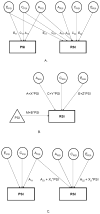Peer substance involvement modifies genetic influences on regular substance involvement in young women
- PMID: 20569232
- PMCID: PMC3046802
- DOI: 10.1111/j.1360-0443.2010.02993.x
Peer substance involvement modifies genetic influences on regular substance involvement in young women
Abstract
Aims: Peer substance involvement (PSI) is a robust correlate of adolescent substance use. A small number of genetically informative studies suggest that shared genetic and environmental factors contribute to this association. We examine mechanisms by which PSI influences the etiology of regular substance involvement (RSI), particularly in women.
Design: Population-based cohort study of twin women from the US Midwest.
Participants: 2176 twin women.
Measurements: To examine the relationship between self-reported PSI during adolescence and a composite RSI representing regular tobacco, alcohol and cannabis use during young adulthood, using genetically informative correlation, moderation and joint correlation-moderation models.
Findings: There was evidence for a significant additive genetic X environment interaction. PSI was moderately heritable (h(2) = 0.25). Genetic, shared and non-shared influences on RSI overlapped with influences on PSI (genetic correlation of 0.43). Even after controlling for these shared genetic influences, RSI was more heritable in those reporting greater PSI.
Conclusions: While young women may select peers based on certain dispositional traits (e.g. permissiveness towards substance use), the social milieu constructed by PSI does modify the architecture of increased RSI in those individuals with increasing levels of PSI being associated with stronger expression of heritable influences.
© 2010 The Authors, Addiction © 2010 Society for the Study of Addiction.
Figures


Comment in
-
Commentary on Agrawal et al. (2010): Social environments modulate alcohol use.Addiction. 2010 Oct;105(10):1854-5. doi: 10.1111/j.1360-0443.2010.03151.x. Addiction. 2010. PMID: 20860079 Free PMC article. No abstract available.
Similar articles
-
Common and drug-specific genetic influences on subjective effects to alcohol, tobacco and marijuana use.Addiction. 2011 Jan;106(1):215-24. doi: 10.1111/j.1360-0443.2010.03129.x. Epub 2010 Oct 19. Addiction. 2011. PMID: 20955487 Free PMC article.
-
Role of overlapping genetic and environmental factors in the relationship between early adolescent conduct problems and substance use in young adulthood.Addiction. 2016 Jun;111(6):1036-45. doi: 10.1111/add.13303. Epub 2016 Feb 27. Addiction. 2016. PMID: 26748618 Free PMC article.
-
Progression in substance use initiation: A multilevel discordant monozygotic twin design.J Abnorm Psychol. 2015 Aug;124(3):596-605. doi: 10.1037/abn0000068. J Abnorm Psychol. 2015. PMID: 26098047 Free PMC article.
-
The genetic epidemiology of cannabis use, abuse and dependence.Addiction. 2006 Jun;101(6):801-12. doi: 10.1111/j.1360-0443.2006.01399.x. Addiction. 2006. PMID: 16696624 Review.
-
Review of twin and adoption studies of adolescent substance use.J Am Acad Child Adolesc Psychiatry. 2003 Jun;42(6):710-9. doi: 10.1097/01.CHI.0000046848.56865.54. J Am Acad Child Adolesc Psychiatry. 2003. PMID: 12921479 Review.
Cited by
-
Genetically informative research on adolescent substance use: methods, findings, and challenges.J Am Acad Child Adolesc Psychiatry. 2010 Dec;49(12):1202-14. doi: 10.1016/j.jaac.2010.09.004. Epub 2010 Oct 20. J Am Acad Child Adolesc Psychiatry. 2010. PMID: 21093770 Free PMC article. Review.
-
Genetic and Environmental Interplay in Adolescent Substance Use Disorders.Curr Addict Rep. 2015 Jun;2(2):122-129. doi: 10.1007/s40429-015-0049-8. Curr Addict Rep. 2015. PMID: 26301173 Free PMC article.
-
Advanced paternal age at birth: phenotypic and etiologic associations with eating pathology in offspring.Psychol Med. 2014 Apr;44(5):1029-41. doi: 10.1017/S0033291713001426. Psychol Med. 2014. PMID: 23795717 Free PMC article.
-
Commentary on Agrawal et al. (2010): Social environments modulate alcohol use.Addiction. 2010 Oct;105(10):1854-5. doi: 10.1111/j.1360-0443.2010.03151.x. Addiction. 2010. PMID: 20860079 Free PMC article. No abstract available.
-
Gene-environment interplay between parent-child relationship problems and externalizing disorders in adolescence and young adulthood.Psychol Med. 2015 Jan;45(2):333-44. doi: 10.1017/S0033291714001445. Epub 2014 Jun 23. Psychol Med. 2015. PMID: 25066478 Free PMC article.
References
-
- Adrados JL. The influence of family, school, and peers on adolescent drug misuse. Int J Addict. 1995 Sep;30(11):1407–23. - PubMed
-
- Bahr SJ, Marcos AC, Maughan SL. Family, educational and peer influences on the alcohol use of female and male adolescents. J Stud Alcohol. 1995 Jul;56(4):457–69. - PubMed
-
- Brook JS, Brook DW, De La RM, Duque LF, Rodriguez E, Montoya ID, et al. Pathways to marijuana use among adolescents: cultural/ecological, family, peer, and personality influences. J Am Acad Child Adolesc Psychiatry. 1998 Jul;37(7):759–66. - PubMed
-
- Bauman KE, Ennett ST. On the importance of peer influence for adolescent drug use: commonly neglected considerations. Addiction. 1996 Feb;91(2):185–98. - PubMed
-
- Ellickson PL, Tucker JS, Klein DJ, Saner H. Antecedents and outcomes of marijuana use initiation during adolescence. Prev Med. 2004 Nov;39(5):976–84. - PubMed

